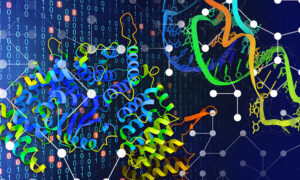New insights into epigenetic modifications
Scientists at EMBL Rome unveil the mechanism behind the most studied epigenetic modification.

‘DNA makes RNA makes protein’ is a fundamental principle in molecular biology. The process of gene expression, namely creating RNA from a specific DNA sequence, is tightly regulated in different ways. The DNA itself carries a reversible chemical modification – called methylation – that can influence gene expression.
Scientists at EMBL Rome, in collaboration with Tim Bestor at Columbia University in New York and John Edwards at Washington University in St. Louis, Missouri, now show for the first time how DNA methylation instructs cells to repress parts of their genome by inducing the assembly of a silencing complex. Their work was published in Proceedings of the National Academy of Sciences (PNAS).
DNA methylation is the only epigenetic modification known to be inherited when cells divide, meaning once a specific DNA sequence is methylated it remains in that state throughout the lifespan of an organism. Methylation acts like a mark on the DNA that inactivates some genes in a manner that is dependent on the parental origin. DNA methylation also acts as a cellular defense mechanism against parasitic pieces of DNA that can move within the genome and threaten its integrity. The modification instructs cells to repress these so-called transposons.
Despite four decades of research, the precise mechanism by which DNA methylation represses gene expression has remained unknown. The scientists in Mathieu Boulard’s group found that the protein TRIM28, which is a known silencing factor that had not been previously linked to DNA methylation, is required for the repression of methylated genes. However, TRIM28 does not directly interact with DNA, which meant that other proteins must be involved in the process.
Using a combination of genetic and biochemical analyses they showed that in the presence of DNA methylation, TRIM28 binds to the enzyme OGT, which modifies other proteins by adding sugar groups (a process known as glycosylation). They also show that methylation-directed glycosylation of specific DNA binding proteins prevents methylated genes from being expressed.
“Our study reveals that protein glycosylation plays a central role in DNA methylation, thereby unveiling the mechanism behind the most studied epigenetic modification,” explains Matthieu Boulard, Group Leader at EMBL Rome.
The first evidence that glycosylation plays a major function in gene regulation came from another study at EMBL, which showed that glycosylation represses developmental genes in certain cells during the development of the fruit fly Drosophila. However, gene repression in this case does not involve DNA methylation.
Boulard says: “We show that DNA methylation in mammals induces gene silencing by activating a process that induces glycosylation of regulatory factors. These findings address one of the core questions in the field of epigenetics, which is the nature of the mechanism that represses methylated promoters.”
Nuove luci sull’epigenetica
Gli scienziati dell’EMBL di Roma svelano il meccanismo alla base della più studiata modificazione epigenetica.
“Il DNA porta a RNA che porta a proteina” è un principio fondamentale della biologia molecolare. Il processo di espressione genica, cioè la produzione di RNA a partire da una specifica sequenza di DNA, è finemente regolato a diversi livelli. Lo stesso DNA può subire una modificazione chimica reversibile – chiamata metilazione – in grado di influenzare l’espressione genica.
Gli scienziati dell’EMBL di Roma, in collaborazione con Tim Bestor della Columbia University di New York e John Edwards della Washington University di St. Louis, Missouri, sono riusciti per la prima volta a dimostrare con quale meccanismo la metilazione del DNA istruisce le cellule a reprimere intere parti del loro genoma assemblando complessi di proteine inibitorie. Il loro lavoro è stato pubblicato su Proceedings of the National Academy of Sciences (PNAS).
La metilazione del DNA, per quanto ad oggi noto, è l’unica modifica epigenetica che viene ereditata quando le cellule si dividono. La metilazione, dunque, è come un marchio sul DNA in grado di inattivare i geni in base alla loro origine parentale. La metilazione è anche alla base del meccanismo di difesa cellulare contro i trasposoni – piccole sequenze di DNA “parassita” che si muovono all’interno del genoma e ne minacciano l’integrità. Attraverso la metilazione, l’espressione dei trasposoni viene infatti repressa.
Nonostante quattro decenni di ricerca, il meccanismo preciso con cui la metilazione del DNA reprime l’espressione genica è rimasto sconosciuto. Gli scienziati del gruppo di Matthieu Boulard, Group Leader dell’EMBL di Roma, hanno scoperto che il fattore essenziale perché i geni metilati siano repressi è la proteina TRIM28 – un fattore di inibizione dell’espressione genica che era noto ma che non era mai stato collegato alla metilazione del DNA. Tuttavia, TRIM28 non interagisce direttamente con il DNA, e dunque altre proteine devono essere coinvolte in questo processo.
Utilizzando una combinazione di analisi genetiche e biochimiche i ricercatori hanno dimostrato che la metilazione del DNA porta TRIM28 a legare l’enzima OGT, il quale a sua volta modifica altre proteine aggiungendo molecole di zucchero (un processo noto come glicosilazione). Gli stessi ricercatori hanno poi dimostrato che la glicosilazione di specifiche proteine legate al DNA impedisce l’espressione dei geni metilati.
“Il nostro studio rivela che la glicosilazione delle proteine svolge un ruolo centrale nella metilazione del DNA, svelando così il meccanismo alla base della modificazione epigenetica più studiata”, spiega Matthieu Boulard,
La prima evidenza che la glicosilazione svolge una funzione importante nella regolazione dei geni era venuta da un altro studio dell’EMBL, che aveva dimostrato come la glicosilazione reprime alcuni geni durante lo sviluppo embrionale nel moscerino della frutta Drosophila. Tuttavia, la repressione genica in questo caso non coinvolge la metilazione del DNA.
“Abbiamo dimostrato – spiega Boulard – che la metilazione del DNA nei mammiferi induce la repressione dei geni attivando un processo che induce la glicosilazione dei fattori regolatori. Questi risultati affrontano una delle questioni fondamentali nel campo dell’epigenetica, e cioè quale sia la natura dei meccanismi che portano alla repressione dei promotori metilati”.



